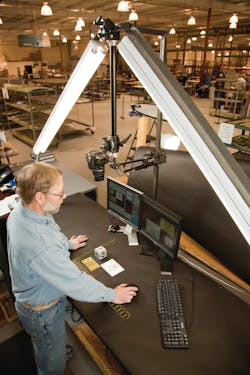It was the '50s. The days of Elvis and James Dean, where Saturday night meant drive-ins and roller rinks. From the fins on a pink Plymouth convertible to the leather jacket that fit just right, aviation-inspired style had arrived and it was everywhere. From small town USA to the big city lights, this was the jet aviation era -- a time of iconic style, innovation, and quality built to last.
It was the '50s. In Perryville, a small town nestled in the farmlands of southeast Missouri, fledgling aviation company Sabreliner Corporation was creating the first twin-engine business jet, its namesake Sabreliner. At the same time the Sabreliner 40 Model was coming to life, another unique aircraft was being born out on the West Coast, the KC-135 Stratotanker. This aircraft and aircraft expert Sabreliner Corporation would continue to share a path leading to the present day.
The KC-135 Stratotanker
The Boeing Company's 367-80 platform evolved into the 707 passenger plane as well as the KC-135 Stratotanker next generation aerial refueling platform. In August 1956, the Stratotanker completed its first flight and it began its military service life a year later. Since then, it has provided the core aerial refueling capability for the U.S. Air Force, while offering support to the Navy, Marine Corps and allied nation aircraft for more than 50 years. This aircraft enhances the military’s capability to accomplish its primary mission of global reach. While it’s primarily known for its refueling capabilities, the KC-135 also has been used for transporting cargo, as well as ambulatory patients using patient support pallets during aeromedical evacuations.
According to the aircraft's Air Force spec sheet, four turbofans, mounted under 35-degree swept wings, power the KC-135 to takeoffs at gross weights of up to 322,500 pounds. Depending on fuel/storage configuration, the KC-135 can carry up to 83,000 pounds of cargo.
Nearly all internal fuel can be pumped through the flying boom, the KC-135’s primary fuel transfer method. A boom operator is stationed in the rear of the plane and controls the boom during in-flight air refueling. Some aircraft have been configured with the multipoint refueling system, which consists of special pods mounted on the wingtips. These KC-135s are capable of refueling two receiver aircraft at the same time.
In 1954, the Air Force purchased the first 29 of what would become a fleet of more than 700 aircraft. The last KC-135 was delivered in 1965 and more than 400 of the aircraft are still in service today.
The KC-135 was expected to retire years ago based on a predicted number of flight hours accrued on the airframe. As with many other military aircraft, the KC-135 is now flying well beyond its original design service goal in terms of flight hours. Mission changes and structural modifications including upgrades and repairs have changed the life expectancy of the KC-135 in ways not envisioned by the original designers.
An aging aircraft meets an aging aircraft expert
In 2010, Sabreliner was awarded a United States Air Force (USAF) contract with the Center for Aircraft Structural Life Extension (CAStLE). The research and engineering activities performed by CAStLE, a USAF Center, located at the Air Force Academy in Colorado Springs, CO, cover a variety of tasks that follow aircraft and other structures through their life cycle from cradle to grave.
CAStLE provides aircraft structural integrity technology to the Air Force and private sector organizations. Its experts research ways to keep the Air Force’s aging aircraft fleet in operation by ensuring the existence of extended life cycles, lower maintenance costs, and improved pilot safety.
So, why keep these aircraft in service?
"Simply put, continuing to keep older aircraft flying may sometimes be more cost effective than procuring new ones. Economical sustainment requires moving away from a 'find and fix' mentality to one of 'anticipate and manage,'” says Mike Fallert, director of Sabreliner Corporation's Ste. Genevieve, MO, operations where the KC-135 work is performed.
The teardown initiative
This “anticipate and manage” effort set in motion the largest and most comprehensive teardown effort ever conducted for the U.S. military. As part of its contract with CAStLE, Sabreliner and its team of subcontractors began a two-year structural teardown, an autopsy per se, on a 1957 model KC-135E. The aircraft was previously retired and later retrieved from the 309th Aerospace Maintenance and Regeneration Group (AMARG), located at Davis-Monthan Air Force Base, in order to conduct a comprehensive teardown and analysis of the fuselage, empennage and wings.
To get the project started, the aircraft was cut into large sections referred to as "lots" and trucked across the country to Ste. Genevieve, a small historic town that lies 60 miles south of St. Louis along the Mississippi River. The lots then entered a very methodical teardown process defined by CAStLE-developed protocols that, according to the director of CAStLE, Sabreliner has “industrialized” over the past two years. The lots were cut into sections; the sections were precisely disassembled into parts; and the parts were stripped of their paint and fuel sealant. After consuming thousands of drill bits and utilizing terabytes of computer storage for the thousands of high-resolution photographs documenting each and every part, the parts then entered a very disciplined inspection process in search of fatigue cracks and corrosion caused by five decades of flying. Once these indications were found, the parts were shipped to the Air Force Academy where an intense metallurgical failure analysis took place.
The project concluded with a detailed summary of the findings in a comprehensive 1,437-page final report.
"This report will help government officials determine not only the current condition of the fleet, but the long-term structural viability to support and potentially exceed the goal of flying these aircraft through 2040," says Fallert.
The expanding need for aircraft structural teardown analysis has created a unique niche for Sabreliner Corporation. It continues to support the vital mission of aircraft structural integrity as it progresses through its fifth teardown in two and a half years. Teardowns have been performed on four different mission design series (MDS) aircraft consisting of two KC-135s, a T-38, a C-130, and a Boeing 707.
Its 2013 and two timeless veterans are still in service to the nation. While the KC-135's mission has remained the same since the aircraft's inception, Sabreliner Corporation's mission has diversified since production of the first business jet in the '50s. While Sabreliner today supports its fleet, it also specializes in aircraft maintenance, repair, and overhaul (MRO), airframe structural repair, engine overhaul, as well as manufacturing high-quality parts for fixed- and rotary-wing aircraft.
It was the '50s. And while its style has long faded, both Sabreliner and the KC-135 continue to be in service, proving that no matter the era, one thing remains the same: quality is timeless.
For more information on Sabreliner visit www.sabreliner.com. Kristen Lalumondiere, with Sabreliner Corporation in Ste. Genevieve, assisted with the article. For more information on CAStLE visit http://www.usafa.edu/df/dfe/dfer/centers/castle/.
Ann Hein is a journalist specializing in the business aviation industry. Hein worked for Jet Aviation for 19 years in a series of progressively responsible positions culminating in the role of director, PR and communications for the Americas. In that role, she directed and implemented all external and internal communications initiatives and was the spokesperson for Jet Aviation to the media in the U.S. Prior, Ann served as director, marketing & employee communications for Jet Aviation St. Louis (formerly Midcoast Aviation). Ann is an honors college graduate of the University of Missouri at Columbia with a bachelor’s degree in journalism. She also is a life member of the Golden Key National Honor Society. She can be reached at [email protected].

